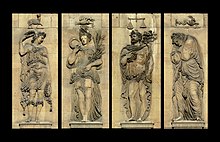This article needs additional citations for verification. (August 2023) |
There are a number of deities and personifications associated with seasons in various mythologies, traditions, and fiction.

Winter
edit- Beira, Queen of Winter, also Cailleach Bheur, a personification or deity of winter in Gaelic mythology
- Boreas (Βορέας, Boréas; also Βορρᾶς, Borrhás) was the Greek god of the cold north wind and the bringer of winter. His name meant "North Wind" or "Devouring One". His name gives rise to the adjective "boreal".
- Khione (from χιών – chiōn, "snow") is the daughter of Boreas and Greek goddess of snow
- Ded Moroz (literally "Grandfather Frost"), a Russian substitute of Santa Claus
- Itztlacoliuhqui, deified personification of winter-as-death in Aztecan mythology
- Jack Frost
- Tengliu, Snow goddess from Chinese mythology.
- the Great Winter God (冬大神), of Ba Jia Jiang (The Eight Generals), originated from the Chinese folk beliefs and myths
- Marzanna, slavic Goddess of Winter, Death, and Rebirth (also Marena, Morena, Morana, Mara, Maslenitsa).
- Morozko, from a Russian fairy tale, translated as Father Frost
- Old Man Winter, personification of winter.
- Frau Holle Germanic mother frost.
- Skaði (sometimes anglicized as Skadi, Skade, or Skathi) is a jötunn and goddess associated with bowhunting, skiing, winter, and mountains in Norse mythology
- Three Friends of Winter in Chinese art, the plum, bamboo and pine.
- Nane Sarma, Grandma Frost, Iranian folklore.
Spring
edit- Ēostre, West Germanic spring goddess; she is the namesake of the festival of Easter in some languages.
- Brigid, celtic Goddess of Fire, the Home, poetry and the end of winter. Her festival, Imbolc, is on 1st or 2nd of February which marks "the return of the light".
- Persephone, Greek Goddess of Spring. Her festival or the day she returns to her mother Demeter from the Underworld is on 3rd of April.
- Many fertility deities are also associated with spring
- In Roman mythology, Flora was a Sabine-derived goddess of flowers[1] and of the season of spring[2]
- Jarylo (Cyrillic: Ярило or Ярила; Polish: Jaryło; Croatian: Jura or Juraj; Serbian: Jarilo; Slavic: Jarovit), alternatively Yarylo, Iarilo, or Gerovit, is a Slavic god of vegetation, fertility and springtime.[3]
- the great Spring God (春大神), of Ba Jia Jiang (The Eight Generals), originated from the Chinese folk beliefs and myths
Summer
editAutumn
edit- the Great Autumn God (秋大神), of Ba Jia Jiang (The Eight Generals), originated from the Chinese folk beliefs and myths
Anemoi
editIn ancient Greek mythology Anemoi were the gods of wind, some of which were associated with seasons:
- Boreas (Septentrio in Latin) was the north wind and bringer of cold winter air
- Zephyrus or Zephyr (Favonius in Latin) was the west wind and bringer of light spring and early summer breezes
- Notus or Notos (Auster in Latin) was the south wind and bringer of the storms of late summer and autumn. Notos not only brings rain and heavy downpour, but he can also bring extremely hot air (avg. 45°C) especially in the southern parts of Greece.
- Eurus (Eurus in Latin) was the East Wind & bringer of warmth & rain
References
edit- ^ H. Nettleship ed., A Dictionary of Classical Antiquities (1891) p. 238
- ^ "Flora". Myth Index. Archived from the original on 2016-05-03.
- ^ source of Jarilio name in IAU Nomenclature
External links
edit- Media related to Seasonal deities at Wikimedia Commons